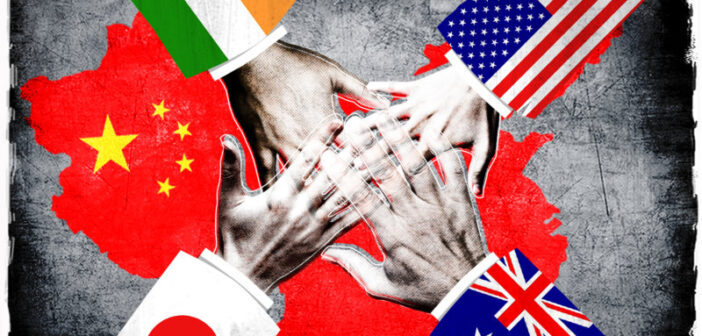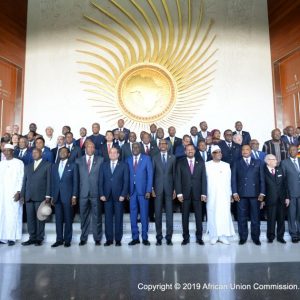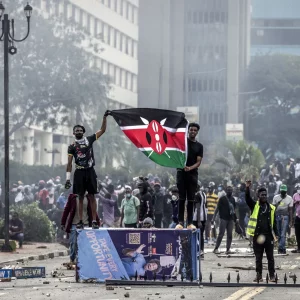In my last article, I detailed some of the strategic and technological changes that the U.S. needs to make to its military strategy to successfully deter China from military action in East Asia. Though maintaining our military edge is important, China is a rising power while the U.S. is in relative decline. China has both an enormous population and home-field advantage. It is only a matter of time before China completely erodes the U.S.’s ability to unilaterally defend its Asian allies. Therefore, it is crucial that a military buildup is acknowledged as only delaying the inevitable and the true path to defending the free countries of Asia lies in the creation of a defensive pact — an Asian NATO.
While no such holistic defensive pact exists in Asia, Washington has alliances with several countries in the region. Official mutual defense pacts are currently in effect with Japan, the Philippines, Australia, and South Korea. Furthermore, the Taiwan Relations Act of 1979 includes an implicit threat of U.S. involvement should China seek to invade the island. Less formally, the United States, Japan, India, and Australia have recently revived the Quadrilateral Security Dialogue (or the Quad). The Quad is essentially designed to serve as a counterbalance to China in the region by conducting joint military drills and serving as a forum for cooperation.
Although Washington has been conducting such drills with Tokyo and Canberra for decades, what makes the Quad special is the membership of India, which is not a traditional ally of the U.S. While India was officially neutral during the Cold War, they shared a “special relationship” with the Soviet Union, underscored by a friendship treaty as well as close defense, economic, and diplomatic ties. Furthermore, as recently as last October, Prime Minister Narendra Modi of India and President Xi Jinping of China were hailing a “new era of cooperation between [their] two countries.”
With China being India’s second-largest trading partner and New Delhi having no historical friendship with Washington, India has long been reluctant to be sucked into any U.S.-led effort to contain Beijing. But the situation has changed drastically over the last year. After being dealt a stinging defeat by China in the deadly Himalayan clashes over the summer, a consensus among Indian policymakers has emerged; Beijing poses a major threat, and can only be countered by aligning New Delhi with Washington and other Asian democracies.
A further threat to Indian security is the warming relationship between China and Pakistan. Should hostilities erupt with either power, New Delhi faces the strong possibility of having to wage a two-front war to its north and west. On their own, either country would pose a major threat to India. Combined, India would likely be quickly overwhelmed. Though an all-out conflict on this scale remains unlikely, even the possibility of it has New Delhi extremely concerned and looking toward Washington for support. And as India has the fifth largest economy, second highest population, and fourth most powerful military in the world, Washington has warmly accepted New Delhi’s overtures.
While the Quad marks progress, it is woefully insufficient to deter China because it lacks any kind of formal treaties or alliances binding India to the U.S, Japan, and Australia. When China attacked Indian positions in the Himalayas over the summer and killed twenty servicemembers, India had no allies to call to its aid. And due to China’s stronger military and better infrastructure, India has proved unable to successfully repel such encroachments. This had led many in New Delhi to warm to the idea of an official alliance with the U.S., illustrating how far ties have progressed since the start of the decade.
With New Delhi seeking protection from Beijing, the time is ripe for Washington to fully embrace India into the American-led defense apparatus. Washington should begin by formalizing the Quad into an official defense alliance, but their ambitions should stretch well beyond this. In 2007, former Prime Minister of Japan Shinzo Abe proposed the creation of an “Asian Arc of Democracy” to counter Beijing.
This arc would encompass East Asian democracies in the region stretching from India, down to Australia, and up to Japan. This idea was initially met with skepticism across the region as growing economic ties between China and others in the region dominated the calculus back then. However, in recent years, China’s aggression in the South China Sea, Taiwan Strait, Himalayas, and meddling in Australia and South Korea has woken democracies up to the threat Beijing poses. With security concerns now at the forefront of considerations, the time is ripe to craft the fears of Asian democracies into a formal alliance between the free peoples of Asia and the United States.
Such an alliance would begin with the Quad. With Australia and Japan already boating formal alliances with the U.S., the key will be to get India on board. For the reasons mentioned above, New Delhi is likely to respond favorably to such a bold proposal. Not only would it help safeguard them from China, but it would also all but guarantee that Pakistan would not opportunistically attack if hostilities with China were to ever escalate. While such a proposal would have been too controversial a decade ago, New Delhi’s fear of a two-front war may prove sufficient to convince them to take this step.
A crucial target in the expansion of the alliance would be Taiwan, as they are the most vulnerable to Chinese aggression. Taiwan would likely leap at the chance to gain any formal commitment of involvement from the United States and other Asian powers due to Beijing’s frequent rhetoric promoting forceful reunification. However, great care would need to be taken in any kind of diplomacy involving Taiwan. Any move by Washington to disregard the ‘one China’ policy — the bedrock of the Sino-U.S. relationship where the U.S. does not recognize Taiwanese claims to statehood — would almost certainly lead to a Chinese invasion of the island. Taiwan could still join the alliance, but they would need to be incorporated into the organization as a ‘concerned party’ or any other term which does not imply statehood.
Other likely targets would be South Korea and the Philippines. However, both countries boast leaders who are wary of the U.S. and hesitant to criticize Beijing. In South Korea, the conservative parties who are the most vocal supporters of the U.S. alliance are out of power, and the current President, Moon Jae-in, is a member of the left-leaning Democratic Party. He has shown little willingness to confront China, often muting criticism to avoid Beijing’s ire. However, with elections approaching in 2022 and Moon unable to run for another term, a conservative more hostile towards China may soon take charge.
In the Philippines, a similar dynamic is in place. President Rodrigo Duterte has generally been vocal in his opposition to the U.S. Throughout his presidency, he has called for a “separation” from the U.S., suspended joint military drills, and told President Obama to “go to hell” as he courted Chinese economic support. Over the past few months however, as COVID-19 ravages the Philippines and China shows no willingness to back down from its claims of sovereignty over Filipino territory in the South China Sea, Duterte has swung back toward the U.S. to some degree. But most importantly, the Filipino people and the military remain staunchly pro-American, with 92 percent of Filipinos having a positive opinion of the U.S. in 2015. And like in South Korea, elections will be held in 2022 and Duterte is ineligible to run for another term, meaning that there is a strong possibility of a pro-American president soon coming to power.
Looking at the region more broadly, most other countries — namely Thailand, Cambodia, Laos, Myanmar, Nepal, Shi Lanka, and Bhutan — are off the table due to their geopolitical alignment or being too costly to protect. There are a few countries, though, that would make good additions in the future. Vietnam seems like the most likely candidate, as they boast warming security ties with the U.S. However, as they are run by an authoritarian communist regime, they would make a poor addition to an ‘arc of democracy’ so long as the current regime clings to power.
As a thriving democracy and close partner of the U.S., Singapore would make a great addition to the alliance. However, unless China begins directly threatening them, Singapore remains unlikely to take a step as provocative as joining a blatantly anti-China alliance in the near future due to strong economic and social ties to China.
Neighboring Malaysia and Indonesia are both also threatened by Chinese encroachments in the South China Sea and could be tempted to join the alliance. However, both countries are still transitioning to a stable democracy. Indonesia struggles with corruption and minority rights while Malaysia just had its first transfer of power in 2018.
Furthermore, similarly to Singapore, they are unlikely to directly align themselves with the U.S. against China due to Beijing’s substantial economic influence. Should Chinese encroachments escalate, the U.S. should seize the opportunity to incorporate both countries into the security apparatus assuming their political systems have been sufficiently liberalized.
Critics to such a proposal would likely point to how the U.S. military is already overextended trying to maintain current commitments as a reason not to make any more. The underlying concern here is valid; the U.S. military is underfunded for the amount of commitments it is expected to take on. It is currently responsible for having troops and equipment on the ground to fight terrorists in Africa and the Middle East, posture against Iran, defend Europe from Russia, and defend Asian allies from China and Japan. Reasonable people can disagree on how much funding for the pentagon should be prioritized or on the merits of certain U.S. military commitments. But the fact is the pentagon is under-resourced relative to policymaker expectations, and this dynamic can have tragic consequences to both service members and military readiness.
However, the proposal for an Asian NATO would not expand Washington’s commitments but instead reduce them. More countries would be drawn into the military apparatus, but Washington is currently unilaterally guaranteeing the security of many of the countries in the region. For example, should China attack the Philippines, only the U.S. would be required to come to their aid with the other countries likely sitting the conflict out. A simple miscalculation by Beijing could easily escalate into a full-blown U.S.-China conflict. But if this alliance is formalized and all the U.S. allies in the region are drawn into a single, cohesive NATO-like alliance, then Chinese aggression against one country would mean aggression against them all. In this case, should China attack the Philippines, they would end up at war with not only the U.S. but other Asian democracies as well. This would undoubtedly change the calculus for Beijing and leave them more cautious about undertaking provocative acts in the region. In short, the U.S. is already committed to the security of the region; changing the security arrangement from bilateral alliances centered on the U.S. to a multilateral alliance containing the U.S. would decrease Washington’s burden by making allies in the region also responsible for each others’ security.
While India is not currently a member of the defense apparatus and would be another country under the protection of the U.S., their sheer size and population would mean that they would be far more of an asset than a burden for Washington. Should the alliance expand beyond the core countries, it will be important for the U.S. to only include larger or more important countries that could pull their weight. Indonesia has a large population, Singapore is an important financial hub, Malaysia is rich in natural resources, and Vietnam is an important trade partner. Pulling countries like Bhutan or Sri Lanka into the security apparatus would not advance U.S. interests and serve as a burden rather than an asset at a time where Washington is already overstretched.
China poses an existential threat to U.S. economic and political interests in the region as well as to the freedom and prosperity of Asian democracies. While in my previous article I talked about what steps the U.S. needs to take militarily to stand against China in the region, the goal is to prevent a war in the first place. The key to that is an effective deterrence, and an Asian NATO-like system containing regional powers like India and Japan would mark the strongest possible deterrence to Chinese aggression. It is in the best interest of Washington to immediately pursue such an arrangement in a bid to strengthen its position in the region by formalizing an alliance with India while also creating an arrangement based on the shared burden of collective security.
Featured Image: The Hills Times











Comments are closed.